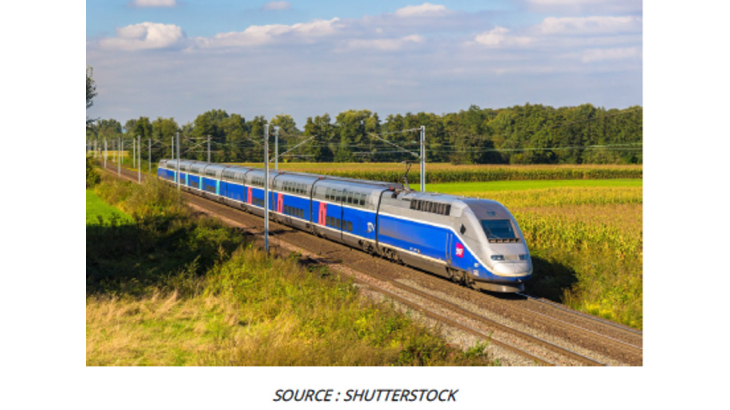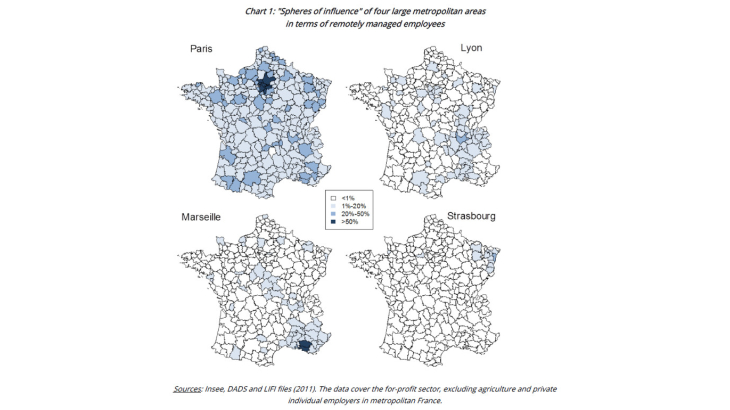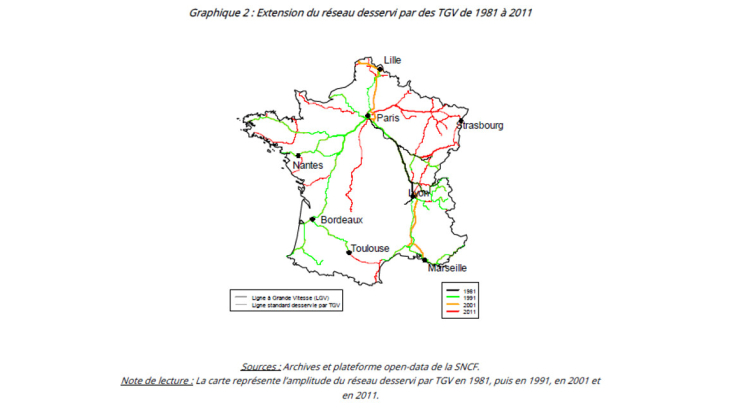The TGV has increased the specialisation of remote subsidiaries in their production activities
The French TGV network has expanded significantly since the opening of its first service on a segment of the line between Paris and Lyon in 1981. The main developments during our analysis period (1993 to 2011) included the opening of the Île-de-France interconnection line as well as the Rhône-Alpes ligne à grande vitesse (LGV – high-speed line) between Lyon and Valence in 1994. The LGV Rhône-Alpes was extended to Marseille in 2001 and the LGV Est connecting Paris and Strasbourg was opened in 2007 (see Chart 2). Commercial speeds on the dedicated TGV network are significantly faster than those attained on the standard railway network, reaching speeds of 300 km/hour to 320 km/hour. Consequently, journey times between newly connected cities have plummeted. As an example, the train journey from Paris to Marseille which took 6 hours and 40 minutes in 1981, was reduced to 4 hours and 40 minutes in 1982 then 4 hours and 18 minutes in 1994, and as of 2001 only takes 3 hours. Equally, the journey time from Paris to Strasbourg was reduced from 3 hours and 55 minutes to 2 hours and 20 minutes in 2007.
In 2011, more than 40% of the subsidiaries of multi-site groups could use the TGV for all or part of the journey to their head office. Our analyses (Charnoz, Lelarge and Trevien, 20171) show that when the journey time between a group's head office and one of its subsidiaries is reduced due to an extension of the TGV network, the group tends to reorganise. It increases the number of jobs in the subsidiary allocated to production activities to the detriment of managerial functions, which are partially relocated to the head office. The net effect on total group employment tends to be slightly positive in most industries.
The magnitude of these workforce reallocations varies substantially depending on the industry. The results obtained are particularly significant in the service sectors, where the availability of the TGV technology is on average associated with one additional full-time equivalent (FTE) employee allocated to production activities, as compared to 20% of one FTE in other business sectors (retail and manufacturing industries). It also leads to the relocation of around one managerial position from the subsidiary to the head office.
The reorganisations have a positive but limited impact on profit margins
Groups reorganise quickly after the opening of a TGV line – typically during the same or following year – and the changes appear to remain stable over a three to five year horizon. The fact that the changes are not subsequently called into question suggests that they generate concrete productivity gains. Unfortunately, this hypothesis is difficult to confirm directly as the productivity of groups with complex organisations is notoriously difficult to assess empirically.
It is however possible to calculate a rough estimate of the TGV's impact on the gross profit margin of those groups affected. Our analyses suggest that it is relatively consistent across the retail, services and manufacturing sectors at between 0.6 and 0.8 percentage points, and reaches a maximum of 1.9 percentage points in the transport sector. These results are statistically significant, although relatively limited in magnitude, and should be compared to average profit margins ranging between 24% and 32% depending on the industry.
These estimates are however likely to under-state somewhat the true impact. Indeed, they incorporate the main channels through which the TGV infrastructure is likely to affect firms’ productivity, but there might be additional mechanisms that have not been taken into account in this study. For example, the TGV infrastructure might also affect the ability of firms to find better or more appropriate suppliers or investors. It might also affect firms’ ability to prospect for customers. Lastly and most importantly, in addition to its impact on firms’ productivity, the TGV infrastructure might have significantly boosted demand, in particular in industries related to tourism.
1 Pauline Charnoz, Claire Lelarge and Corentin Trevien, "Communication Costs and the Internal Organization of Multi-Plant Businesses: Evidence from the Impact of the French High-Speed Rail", Banque de France Working Paper (forthcoming).


